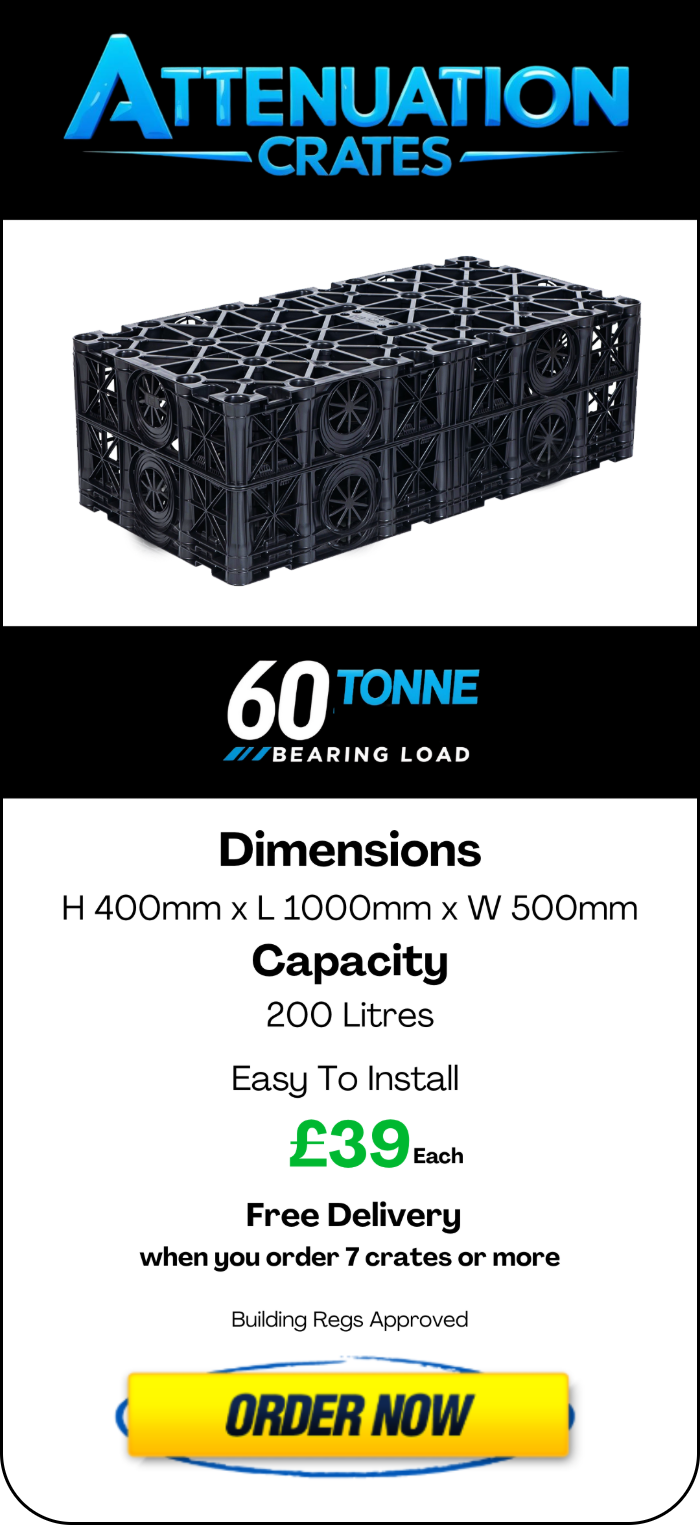Attenuation Tanks and Crates: A Scientific Approach to Stormwater Management in the UK
Abstract
Urbanization and climate change have intensified stormwater runoff, increasing flood risks across the UK. Attenuation tanks and crates, key components of Sustainable Drainage Systems (SuDS), offer effective solutions by storing and gradually releasing rainwater. This white paper examines the hydrological principles, design standards, installation processes, and environmental benefits of these systems, supported by case studies. Optimized for the keywords “attenuation tank” and “attenuation crates,” this article aims to inform developers, engineers, and policymakers while enhancing the online visibility of Builders Yard UK.
1. Introduction
The rapid expansion of urban areas in the UK has transformed natural landscapes, replacing permeable soils with impermeable surfaces like asphalt and concrete. This shift disrupts natural drainage, leading to increased stormwater runoff and heightened flood risks. The Environment Agency reports that over 5 million properties in England are at risk of flooding, a challenge exacerbated by climate change-induced extreme weather events (GOV.UK Flood Risk).
Sustainable Drainage Systems (SuDS) address these issues by mimicking natural water management processes. Among SuDS techniques, attenuation tanks and crates are critical for controlling runoff volume and flow rates. These systems temporarily store excess rainwater, releasing it at a controlled rate to prevent overwhelming drainage networks or watercourses. This article provides a comprehensive analysis of attenuation tanks and crates, exploring their scientific basis, design, implementation, and role in sustainable urban development. For high-quality products, visit Builders Yard UK.
2. Understanding Attenuation Tanks and Crates
2.1 Attenuation Tanks
An attenuation tank is a large, underground structure designed to store stormwater during heavy rainfall, releasing it slowly to mitigate flooding. These tanks are typically constructed from durable materials such as precast concrete, fibreglass, or polyethylene, tailored to site-specific requirements (FLI Precast).
2.2 Attenuation Crates
Attenuation crates, also known as stormwater crates or geocellular units, are modular plastic structures that create underground voids for water storage. Made from recycled polypropylene, these lightweight, stackable units offer high void ratios (over 90%), maximizing storage capacity while minimizing excavation (Drainage Superstore). They are versatile, suitable for residential, commercial, or public spaces, and can be configured for attenuation or infiltration.
2.3 Attenuation vs. Infiltration
Attenuation systems store water temporarily for controlled release into drainage systems or watercourses, while infiltration systems allow water to percolate into the ground, recharging aquifers. Attenuation is preferred in areas with low soil permeability, such as clay-rich regions, where infiltration is impractical (JDPipes). Hybrid systems combining both approaches are increasingly common.
Diagram Placeholder: A schematic illustrating the components of an attenuation tank and crate system would enhance clarity.
For a range of attenuation solutions, explore Attenuation Crates and Attenuation Tanks.
3. The Science Behind Attenuation Systems
3.1 Hydrological Principles
Stormwater management relies on understanding hydrological processes, including runoff, peak flow, and volume control. Runoff is the portion of precipitation that flows over surfaces, increasing in urban areas due to impermeable materials. Peak flow represents the maximum runoff rate during a storm, which attenuation systems aim to reduce. Volume control ensures that the total runoff does not exceed downstream capacity (GRAF UK).
3.2 Mechanism of Action
Attenuation tanks and crates collect runoff from impermeable surfaces via pipes or gullies. The stored water is released through flow control devices, such as orifices or vortex controls, at a rate that mimics pre-development conditions. This process flattens the hydrograph, reducing peak flow and delaying discharge, thus preventing flooding.
3.3 Mathematical Modeling
Designing attenuation systems involves calculating storage volume using models like the Rational Method or hydrograph-based approaches. The storage volume (V) can be estimated as:
\[ V = (Q_p – Q_o) \times T \]
Where:
- Q_p: Peak inflow rate (litres/second)
- Q_o: Allowable outflow rate (litres/second)
- T: Storm duration (seconds)
For example, a site with a peak inflow of 50 L/s, an allowable outflow of 5 L/s, and a 2-hour storm requires approximately 324,000 litres of storage. Advanced software like MicroDrainage refines these calculations (Tricel UK).
Table 1: Key Hydrological Parameters
| Parameter | Description | Typical Value Range |
|---|---|---|
| Peak Inflow (Q_p) | Maximum runoff rate | 10–100 L/s |
| Outflow Rate (Q_o) | Controlled discharge rate | 2–10 L/s |
| Storage Volume | Required tank/crate capacity | 10,000–1,000,000 litres |
| Storm Duration | Length of critical storm event | 1–6 hours |
4. Design Considerations and Standards in the UK
4.1 Regulatory Framework
The UK’s Flood and Water Management Act 2010 mandates SuDS for new developments to reduce flood risk and improve water quality. The Environment Agency and local authorities set discharge limits, often aligning with greenfield runoff rates (typically 2–5 L/s/ha). The CIRIA SuDS Manual (C753) provides detailed design guidance (CIRIA SuDS Manual).
4.2 Design Criteria
Key design considerations include:
- Storage Volume: Based on the 1-in-100-year storm event plus a 40% climate change allowance.
- Discharge Rate: Restricted to pre-development levels or as agreed with authorities.
- Load-Bearing Capacity: Crates and tanks must withstand traffic or soil loads (e.g., 400–700 kN/m² for crates) (Hewitech).
- Maintenance Access: Inspection chambers or tunnels ensure long-term functionality.
4.3 Material Selection
| Material | Advantages | Disadvantages |
|---|---|---|
| Concrete | High durability, load-bearing | Heavy, costly installation |
| Plastic Crates | Lightweight, modular, cost-effective | Limited load capacity in some cases |
| Fibreglass | Corrosion-resistant, durable | Higher cost than plastic |
For material options, visit Builders Yard UK Products.
5. Installation Processes and Best Practices
5.1 Site Assessment
A thorough site assessment evaluates soil permeability, groundwater levels, and topography. Percolation tests determine infiltration feasibility, while topographic surveys guide tank placement (GRAF UK Percolation).
5.2 Installation Steps
- Excavation: Dig to required depth, ensuring stable slopes.
- Base Preparation: Lay compacted gravel or concrete for stability.
- System Assembly: Stack crates or place tanks, securing connections.
- Membrane Installation: Use geotextile and geomembrane to prevent soil ingress.
- Backfilling: Use selected fill to avoid system damage.
- Connection: Install inlet/outlet pipes and flow controls.
- Testing: Conduct leak and flow tests to verify performance.
Diagram Placeholder: A step-by-step installation diagram would clarify the process.
For installation support, see Builders Yard UK Guides.
6. Case Studies
6.1 Copthorne Park and Ride, West Sussex
Rouden Pipetek supplied 8,820 Polystorm-R and Polystorm Inspect crates for a 1.6-million-litre attenuation system at a Gatwick Airport park and ride facility. Completed in 6 weeks, the system manages runoff from extensive paved areas, ensuring compliance with SuDS regulations (Rouden Pipetek).
Key Outcomes:
- Capacity: 1.6 million litres
- Installation Time: 6 weeks
- Load Capacity: 61 tonnes/m²
6.2 Concrete Attenuation Tank in Housing Development
Spanwright installed a 180,000-gallon concrete attenuation tank in a residential project, topped with prestressed concrete slabs to support vehicular loads. The system effectively manages stormwater, reducing flood risk (Spanwright).
Key Outcomes:
- Capacity: 818,000 litres
- Material: Precast concrete
- Application: Residential with traffic loading
For more examples, visit Builders Yard UK Case Studies.
7. Environmental Benefits and Sustainability
Attenuation systems contribute to environmental sustainability by:
- Reducing Flood Risk: Controlled release prevents downstream flooding.
- Improving Water Quality: Sedimentation and filtration remove pollutants.
- Supporting Biodiversity: Integration with swales or ponds creates habitats.
- Adapting to Climate Change: Enhanced capacity for extreme weather events.
Using recycled materials, like polypropylene crates, aligns with sustainability goals (Wavin AquaCell). Learn more at Builders Yard UK Sustainability.
8. Comparison with Other Stormwater Management Solutions
| Solution | Advantages | Disadvantages |
|---|---|---|
| Attenuation Tanks | High capacity, durable | Higher cost, complex installation |
| Attenuation Crates | Modular, cost-effective, easy to install | Limited in high-load areas |
| Soakaways | Recharges groundwater | Ineffective in low-permeability soils |
| Detention Basins | Dual use as recreational space | Requires significant land area |
| Green Roofs | Reduces runoff, insulates buildings | Limited capacity for large storms |
Attenuation systems excel in versatility and can be combined with other SuDS for optimal results (PRS Neoloy). Explore options at Builders Yard UK SuDS Guide.
9. Future Trends and Innovations
9.1 Smart Attenuation Systems
IoT-enabled sensors monitor water levels and flow rates in real-time, optimizing performance and maintenance (Pipelife).
9.2 Rainwater Harvesting Integration
Combining attenuation with harvesting systems provides non-potable water for irrigation or spraying, enhancing sustainability (Freeflush).
9.3 Sustainable Materials
Advancements in recycled and biodegradable materials reduce environmental impact (GRAF UK Crates).
9.4 Policy Developments
Stricter SuDS regulations and climate resilience mandates will drive adoption (Stormwater Legislation).
Discover innovative solutions at Builders Yard UK Innovations.
10. Conclusion
Attenuation tanks and crates are vital for managing stormwater in the UK, addressing flood risks, and promoting sustainable urban development. By adhering to rigorous design standards, leveraging advanced materials, and integrating innovative technologies, these systems ensure resilience against climate challenges. Builders Yard UK offers a comprehensive range of products and expertise to support your projects. Contact us at contact@buildersyard.uk or visit Builders Yard UK.
References
- Environment Agency. (2021). Rainfall Run-off Management for Urban Developments. GOV.UK.
- CIRIA. (2015). The SuDS Manual (C753). CIRIA.
- FLI Precast Solutions. (2022). How Do Attenuation Tanks Work?. FLI Precast.
- Rouden Pipetek. (2017). Case Study: Attenuation Tanks in Copthorne. Rouden Pipetek.
- Spanwright. (2016). Concrete Attenuation Tank 180,000 Gallon. Spanwright.
- GRAF UK. (2024). What is a Stormwater Attenuation Tank?. GRAF UK.
- Tricel UK. (2024). Stormwater Attenuation Tank: Benefits and Implementation. Tricel UK.
- Wavin. (n.d.). AquaCell Attenuation and Infiltration Solutions. Wavin.
- Drainage Superstore. (n.d.). Soakaway Crates and Attenuation Tanks. Drainage Superstore.
- JDPipes. (2021). Difference Between Soakaway and Attenuation Systems. JDPipes.
- Hewitech. (2019). Attenuation Tank Design and Installation. Hewitech.
- Pipelife. (n.d.). High-Capacity Stormwater Attenuation Tanks. Pipelife.
- Freeflush. (n.d.). 3,000 Litre SuDS Rainwater Attenuation Tank. Freeflush.
- PRS Neoloy. (2018). Stormwater Management Systems in the UK. PRS Neoloy.
- Stormwater Management Ltd. (n.d.). Sustainable Drainage Legislation. Stormwater Legislation.


